With a couple of hundred Helium IoT and Mobile deployments under our belt, and Mobile fast becoming of serious interest to lots of folks new to the space, we thought we’d quickly lay out how to use the Helium planner to estimate future rewards.
If you’d prefer a deeper dive into understanding the HIPs that drive this, check out our post on Helium Mobile HIPs over here.
We wrote this for all of you. Whether you have a Saga Phone and a Helium Mobile subscription (and your $BONK), and you want to see how to earn even more MOBILE, or you’re dusting off your old deployment skills and want to get into the WiFi game, this’ll get you up to speed on how to earn the most.
WARNING WARNING WARNING!!!! Rewards will continually go down per radio as more radios join the network. The “pie” stays the same size, and there will be more and more people cutting out slices from it. Those slices will be smaller. Do NOT count on the rewards you see today in the planner being the same rewards you’ll earn by the time you deploy.
Start by going to planner.hellohelium.com and entering in your details. If you don’t have a radio yet, your big decision is whether you go indoor or outdoor.
Indoor Hotspots are cheaper and earn more per hex, but only cover 1-7 hexes. Here’s a Helium Mobile Indoor Hotspot’s coverage using their Planner:
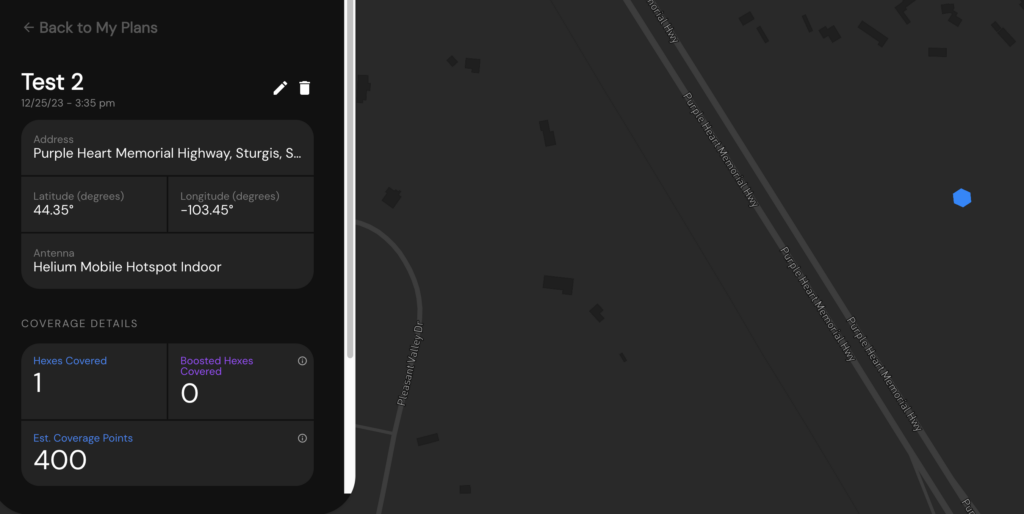
Outdoor Hotspots are more expensive, earn less per hex but can cover thousands of hexes, like this:
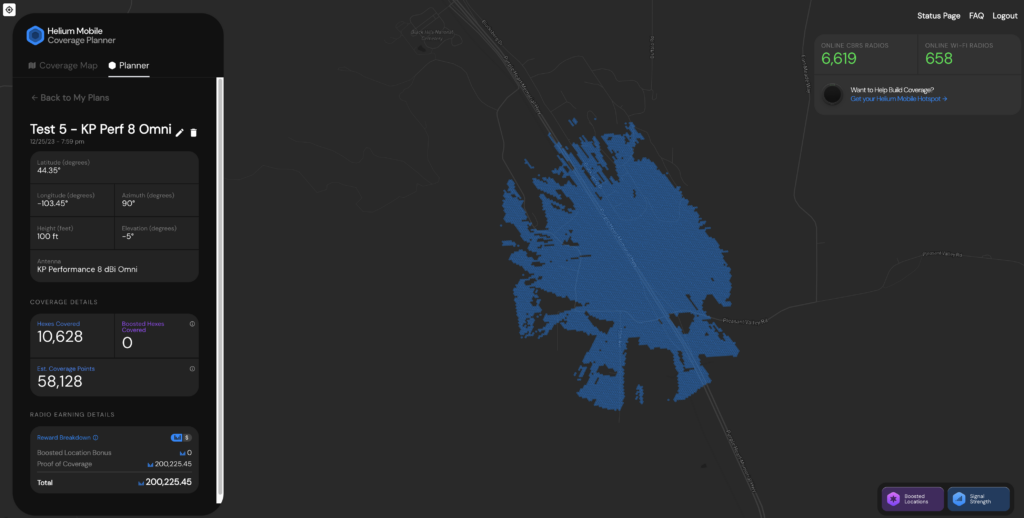
Remember, we’re talking res12 hexes here. We’ve talked about before in our first blog post on the Helium Mobile overview. To give you a quick idea of how big a res12 hex is, here’s a zoomed in screenshot of modeled coverage from an outdoor Mobile Hotspot deployed in Salt Lake City:
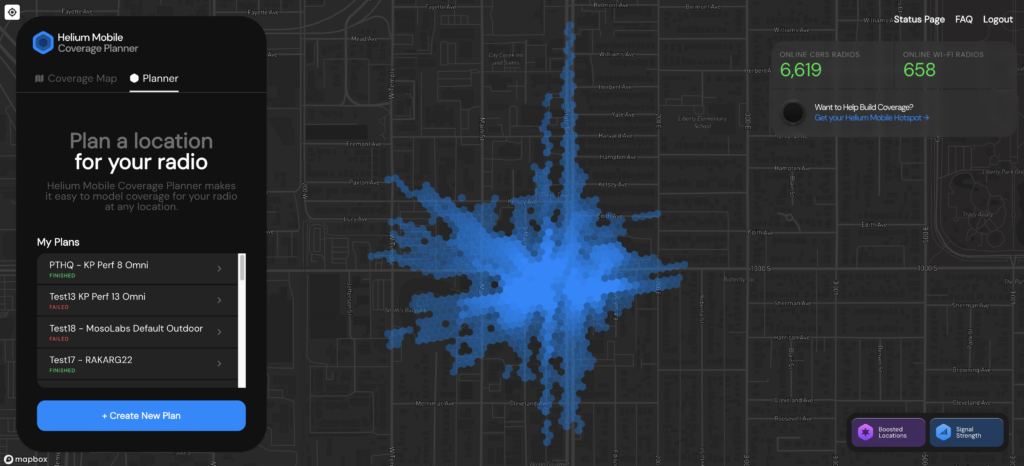
Ok, so you’re probably thinking you’re going BIG, right? I mean, that’s who you are! You’re badass, a silverback gorilla, and gorillas go big!
Relax, turbo. Before you get all crazy about how you’re going to get a 30 dBi antenna and put it on top of the Empire State Building, remember this:
Over the long term, you’re going to earn the most by putting up well deployed Hotspots that provide useful coverage. The same thing that was true for IoT as far as describing useful coverage is true for Mobile.
Useful coverage is WUPU: Wide, Unique, Proveable, and Useful. Each one of those counts, and ultimately, WHAT you deploy depends on the location you have to deploy it.
If all you have is an indoor space, well, don’t worry about putting up some monster antenna in your closet and hoping that radiating your Christmas sweaters will earn you Mobile for years to come. That game will probably only last through Q1 of 2024 before that loophole closes.
If you have an outdoor space, your radio will need to be able to “see” in many directions, especially if it’s an omni directional radio.
You see, we’re not dealing with LoRa anymore, which is a super robust, long distance, low data signal. We’re dealing with something that carries way more data, but over much shorter distances, and it’s, well, there’s no other way to put it: It’s kind of a delicate signal.
It’ll get stopped by buildings, or trees, or big metal signs, or vehicles, or damn near anything you wouldn’t be able to punch through bare-handed full force.
So, where does that leave us? Your best bet is to use the Helium Planner to model out which radio will work the best for you.
Here’s an example of what might go up at the Paleo Treats dessert shop in San Diego, on an outside wall along Adams Ave. The two blue “starfish” you see are where radios are already deployed. The details on the left are what I think we’ll put up.
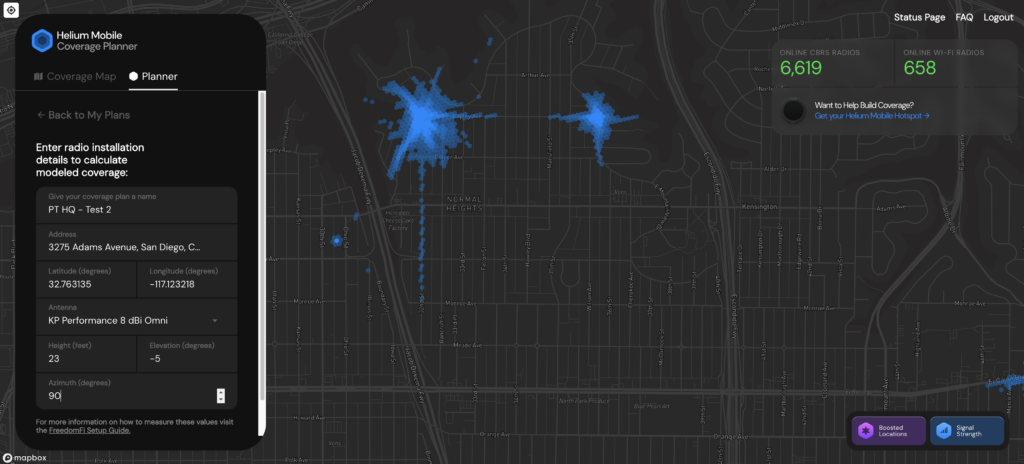
Hit the “Submit Coverage Plan” button at the bottom (not shown above), and you should get something like this:
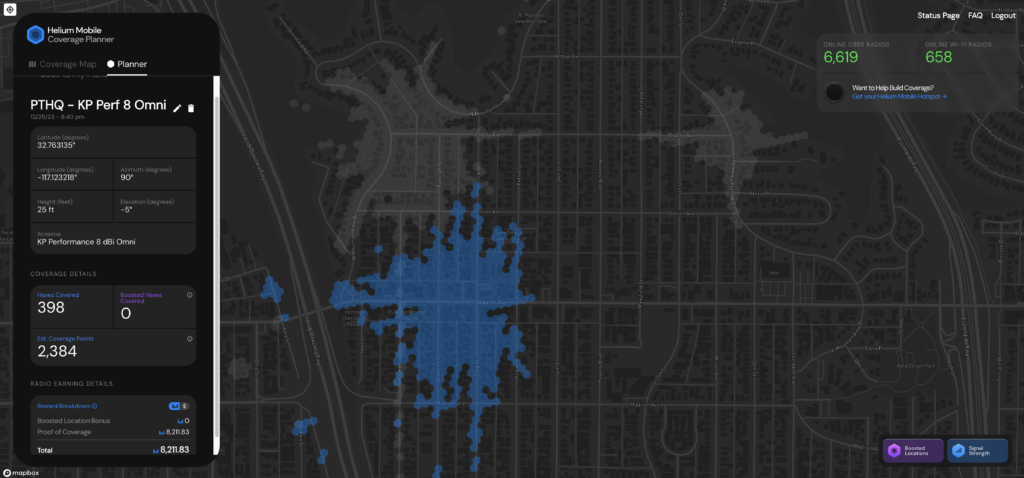
The modeled coverage (what you *should* get) is in blue. Existing modeled coverage is in gray. Watch out for any overlaps; you want your coverage to be as unique as possible.
We’ve made a chart comparing all the radios in “open space”. All of these were run with the same height, elevation, azimuth, and location.
This is NOT real, this is just modeled, and is ONLY useful until the upcoming HIP equalizes earnings for WiFi radios. This is an EXAMPLE of how you might think about this.

Comparing the radios in this way gives you an idea of what *should* happen, although keep in mind that *should* and *will* are two different things, and you should always plan out for YOUR location (not just for Sturgis).
If you’ve got a ton of wide open space and a high building in a place where lots of people gather, well, it sure looks like the KP Performance 8 dBi Omni is a good choice, BUT keep in mind that CBRS won’t always earn this much, and that an upcoming HIP will equalize the WiFi earnings out.
You may be on a narrow street, or overlooking a park, or have a few indoor mall locations. If you have overlapping radio coverage, that will reduce the earnings per radio; here’s a quick table from HIP 85 showing how that make work.

Wherever you are, take the time to carefully assess your locations, and choose your radios and deployments wisely.
This is all changing rapidly; see HIP 101 which lays out a change in earnings, to 1.5x for WiFi Indoor and 2.5x for Outdoor. Once that passes, this will change (obviously) how many tokens you can earn.
One nuance to this is that given this chart from HIP 74:

You might think that CBRS is the way to go because it seems higher power, BUT the way WiFi works is that all signals will be rated at High for all coverage it provides, then the signal goes off a cliff. CBRS, in contrast, slowly drops in power, so even though you cover a hex, it won’t be worth as much. For more on this, see our DePIN State episode with Mario Di Dio, the Head of Wireless Convergence at Nova Labs (the team running Helium Mobile.)
The takeaway here is:
If you want to earn the most short term, deploy CBRS.
If you want to earn the most over the long term, deploy WiFi.
Another aspect here is that far more data is passing through WiFi and none is through CBRS. The comparison is terabytes of data to zero for CBRS.
If you’d like help with this, Max & I (mostly Max) have written many of the HIPs governing Helium Mobile earnings, and we offer consulting calls to help you maximize the rewards you earn by understanding the system.
If you’d like to book time with us, head over here.
Best of luck with your Mobile deployments! Remember to enjoy the whole journey, from research to purchase to deployments to earnings. DePIN is all about creating value at the intersection of the blockchain with the real world; enjoy every aspect of it and you’ll come away with far more than just tokens.
Crush it out there!
Nik & Max
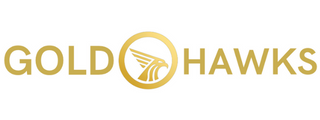
I have been charged for your services three times I have not signed up for your services and have never heard about you. I would like you to take my name out of your system and return my money back. on May 14 2024 $20.68 $20.68 $20.89 .
Hi Sharon,
I don’t think we’re the ones charging you; we sell consulting services, not phone plans. What’s the name on your bill? ~Nik